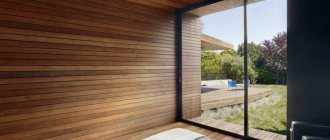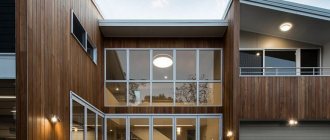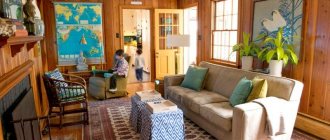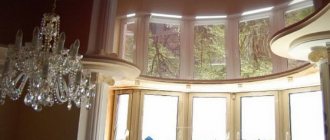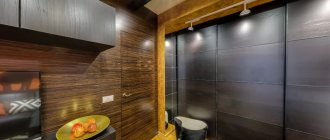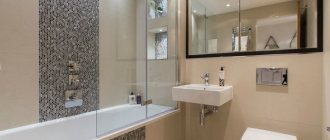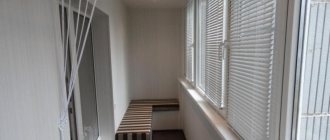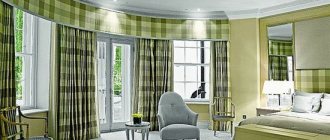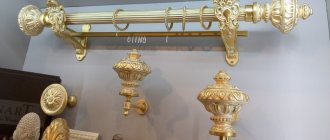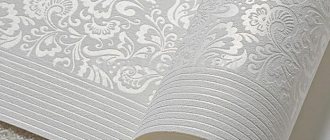Constant change of trends is inherent not only in the world of clothing, shoes and accessories, but also in interior design. More and more innovative materials are appearing, adapted to the lifestyle of modern people. But wood never goes out of style. Wooden panels for interior wall decoration are the best option for creating comfortable conditions.
Area and features of the use of wooden panels for interior wall decoration
The material fits organically into any design. It is distinguished by its uniqueness and grace. Using wood wall panels you can create a unique decorative surface. Due to the specificity of the material and its performance characteristics, the finish is suitable for indoor walls with low humidity. For rooms where this indicator is increased, special panels finished in wood look are used.
In the concept of a modern interior, they can decorate only one wall. For example, near the door, window opening, head of the bed, on balconies, provided that they are glazed.
Using wood wall panels you can create a unique decorative surface.
Image gallery: wood panels in a modern interior
Finally, check out the gallery of images showcasing the versatility and aesthetic appeal of modern panels.
Advantages and disadvantages of wooden panels for wall decoration
Wooden wall panels have many more positive aspects than negative ones. The most tangible and weighty argument in their favor is the simplicity and speed of installation of the material. Plus:
- Variability of products. You can always choose the right specimen from a wide variety;
- Wide choice of palette. If desired, they can always be repainted in the desired color;
- Affordable price range. For a small cost, you can give the room a fashionable and noble look;
- Solid wood panels for walls are of high quality;
- Possibility of creating exclusive, individual models.
Ease of choice due to the many different sizes. This is a natural material, so it is perfectly breathable and does not emit toxic substances at any temperature. This decor does not require particularly careful surface preparation. In addition, behind such panels, shields or slabs you can easily hide communication systems and their components. With proper care, this finish does not lose its original appearance even over time.
This is a natural material, so it is perfectly breathable and does not emit toxic substances at any temperature.
Among the disadvantages is the reduction in the usable area of the room, provided that the installation is carried out in the classical way, which requires a solid frame.
True, there is another way - to put wooden elements on glue. This method requires a surface without drops and cracks.
Among the disadvantages is the reduction in the usable area of the room, provided that the installation is carried out in the classical way.
Advantages and disadvantages
Any finish has its pros and cons. The tree has them too. Among the positive aspects, we can note:
- Great looks
- Environmental friendliness of natural materials
- Heat saving
- Durability
- Ease of material processing
- Easy to install
- Possibility to hide various engineering communications behind the mounted canvas
- Possibility to repaint the coating if necessary
There are also several not very significant disadvantages:
- Not the highest moisture resistance
- Fire hazard
- High price of some types of panels
The disadvantages are largely offset by the fact that wooden panels look great in any interior. Even modern styles fit perfectly with this type of finish.
Any type of such decorative coatings can be subjected to special treatments. This can be either impregnation with compounds that increase the moisture resistance of elements, or giving the surface a certain shade or appearance. The surface that resembles aged wood is especially popular.
Types of wooden panels for walls
By predominant variability we mean not only a wide selection of colors, but also the type of material itself, chipboard, MDF, solid wood, OSB boards and other types.
From the array
Solid natural material is of high quality. The demand for it never falls. This material is often used for finishing offices and libraries. Mostly valuable wood species are used for their production.
Solid natural material is of high quality.
From MDF
Wooden MDF wall panels are made from dry sawdust, pressed using the dry pressing method. Such models are distinguished by high performance properties, ease of installation and maintenance. They can be installed without preliminary preparation of the walls. The panels are equally mounted vertically, horizontally and at an angle. In turn, they are divided into:
- Solid;
- Laminated;
- Glossy;
- With increased moisture resistance.
Solid elements have smooth sides on all sides. Laminated ones can be purchased with any pattern that is applied to the polymer film covering the front side. This treatment gives the product more protection against external influences.
Wooden MDF wall panels are made from dry sawdust, pressed using the dry pressing method.
Veneered
Veneered models are based on the same MDF with its advantageous characteristics. Veneer is a thin sheet of natural wood. More expensive models are made from rare wood. Products made from spruce and pine are slightly more affordable. However, the most common are models made of birch, cherry, walnut, oak, and so on.
Veneer is a thin sheet of natural wood.
OSB boards
In construction markets you can find boards called OSB or OSB. The products differ in that they are made not from sawdust, but from wood chips. Each layer is superimposed on each other perpendicularly, due to which the panels acquire sufficient elasticity and strength. OSB boards are classified where OSB -1 is the cheapest due to its low resistance, and OSB -4 is more expensive as it is resistant and can be used in wet environments.
The products differ in that they are made not from sawdust, but from wood chips.
And other possible options
There are a number of other starting materials existing on the domestic market. Wooden wall panels made of bamboo or rattan are lightweight. They are often used in extravagant interiors. 3D panels are made by hot pressing wood of different species. The result is an interesting product with a profile of a complex configuration. For their production, only rare species of wood are used.
Despite the applied 3D coating, MDF panels are not recommended for installation in areas where there is constant moisture.
Wooden wall panels made of bamboo or rattan are lightweight.
Options for finishing materials by structure
Few people can purchase solid wall panels. But if you want to finish with natural wood, you can use composite materials based on it. Their price is lower than for products made from solid pieces of wood.
The following materials are in great demand:
- MDF. Panels made from fine particles have an average density. Lamination or veneering is applied to the front surface of the boards, imitating natural wood.
- Chipboard. Particle boards are a relatively inexpensive material that comes in the form of panels of various shapes and sizes. The external decorative coating imitates the real structure of wood .
- Fiberboard. Fiberboards are used to produce sheet panels, which can be with or without a decorative coating. In the second case, additional finishing is required after installing the products on the walls.
- OSB. Wood chips are used to make oriented strand boards or sheets. Usually the material is installed under a different finish. In the case of using OSB as a base, after installation, painting is applied to the surface.
Although composite materials imitate real wood as closely as possible, they all have one drawback. In the manufacturing process of wall panels, formaldehyde resins are used, due to which the products lose their environmental friendliness. Many manufacturers try to reduce this disadvantage to a minimum, but natural wood will always outperform its cheap alternatives in terms of quality.
Types of wooden coverings by shape
Wall panels are practical due to the variety of shapes. Using various combinations, you can get an unusual design for a room or space. The correct size of material will help simplify the installation process. There are a number of popular elements.
Using various combinations, you can get an unusual design for a room or space.
Tiles
Wooden slabs for walls are square-shaped models. As a rule, you can find tiles in two sizes: 90 by 90 centimeters and 30 by 30 centimeters. The variety of colors allows you to create different compositions. In most cases, they are used for interior decoration due to ease of installation.
Wooden slabs for walls are square-shaped models.
Slatted panels
Elements in the form of small boards. Their maximum length does not exceed two and a half meters, and their width can vary. Like laminate lamellas, they are attached to each other using a tongue-and-groove connection. They visually expand the room.
Elements in the form of small boards.
Sheets
To save time on finishing work in large rooms, it is optimal to use sheets. Their size on average is 1 meter 22 centimeters by 2 meters and 44 centimeters.
To save time on finishing work in large rooms, it is optimal to use sheets.
And other possible options
A new product on the finishing materials market is gusvar block. This is a type of eurolining with textured relief patterns on the front side. Taking into account the functional purpose of the element, it is secured using a standard tongue-and-groove locking connection.
Depending on the dimensions of the room, as well as its stylistic direction, you can use block house, eurolining, slats, laminate, timber to decorate the walls.
This is a type of eurolining with textured relief patterns on the front side.
Ceiling surface finishing
For this type of work, special wooden panels designed for the ceiling are best suited. They differ from wall ones in their lighter weight and lower strength.
All ceiling coverings are attached either with glue or with prepared lathing. In cases where glue is used, all work comes down to cleaning the main surface and gluing the panels onto it. It’s better to start from the middle of the room, gradually moving from the center to the walls.
If the installation is carried out on a frame, then there will be a little more work. First you need to prepare the base, and then attach the elements of the decorative coating.
The sheathing can be made from wooden blocks. They are best suited because they are inexpensive and it is easier to install the coating on them.
Parts of the frame are attached to the ceiling, according to a previously drawn up diagram. It is necessary to calculate the position of the slats so that the joints of the parts of the coating fall on their surface.
When all the wooden ceiling panels are installed, the joints of the wall and the ceiling panel are decorated with decorative skirting boards.
Color range of wooden panels for walls
An abundance of colors with the possibility of repainting is an ideal option for creating individual interior projects. When choosing the color of the panels, you need to rely on the palette of the room as a whole.
When choosing the color of the panels, you need to rely on the palette of the room as a whole.
White
White is a popular color in residential areas. It is versatile and fits perfectly into any design. At the same time, a solidity of the room is created, which can be diversified with the help of bright accents.
White is a popular color in residential areas.
And other possible options
The restraint and taste of the apartment owners will be conveyed by the beige shade, which, like white, harmonizes perfectly with any interior. This also applies to gray. But with black, despite its classics, you should be careful. They can only decorate one wall.
The restraint and taste of the apartment owners will be conveyed by the beige shade, which, like white, harmonizes perfectly with any interior.
Advantages and disadvantages
Wood is a construction and finishing material that has proven its versatility over thousands of years of practice. Manufacturers offer a wide color palette, from traditional textures and shades to fashionable decorative options. You can choose a cladding made in the Provence style with an aging effect, or in the classic version, with patination or gilding. The popularity of wooden wall coverings is facilitated not only by a large assortment, but also by a unique set of advantages:
- Aesthetics. The wooden surface will provide a stylish look to any size room.
- Reasonable cost and preservation of visual appeal throughout the entire service life.
- Performance characteristics. Wooden panels can withstand significant mechanical loads and are not afraid of accidental impacts.
- Environmental friendliness. Wooden canvas maintains an optimal indoor microclimate, helping to keep cool in summer and warm in winter.
- Soundproofing. A wall covering made of wood (and an additional layer of air behind it) can muffle sounds.
Illuminated wooden panels Source houzz.com
Wooden panels have the following disadvantages:
- Sensitivity to high humidity. A feature typical of most wood and veneer materials. If the design involves installing panels in the kitchen or bathroom, the type must be chosen carefully.
- Reducing usable area. In fact, this drawback is not critical. When wooden cladding is mounted on a frame, the useful volume decreases slightly.
- Additional alignment of walls. It is necessary if the panels are planned to be fastened using an adhesive mixture.
The use of wood panels for different design styles
The color scheme and texture of the material should be taken into account based on the overall concept of the interior of the room. Among the many styles, only a few stand out in interior decoration.
The color scheme and texture of the material should be taken into account based on the overall concept of the interior of the room.
Scandinavian
Northern style. It is dominated by light shades. Slat panels painted in light blue and green shades will fit perfectly. They will make the atmosphere in the house more comfortable.
In the Scandinavian style, light shades predominate.
Provence
Romantic features are characteristic of French Provence with its lavender melodies. Wooden panels for light-colored walls fit here. Shades of gray, blue and green predominate.
Romantic features are characteristic of French Provence with its lavender melodies.
Loft
An ultra-modern direction of interior design, which welcomes a certain “roughness” and the use of elements bestowed by nature itself. In it, like in no other interior, panels of a natural shade would be appropriate.
In a loft style, panels of a natural shade would be appropriate as in any other interior.
And other possible options
The use of wood is relevant for the classical style, as well as modern. To decorate a room, it is better to use light colors, and it is advisable to install dark-colored boards closer to the floor, creating contrast.
The use of wood is relevant for the classical style, as well as modern.
Design ideas
We have considered the main points in the selection options, now we move on to the ideas for designing the interior itself using wooden panels.
- As practice shows, wood looks good not only in its natural environment, but also in the design of premises, and is also a universal material for finishing walls and ceilings.
- In the photo below you can contemplate the design of a house built in 1948 and decorated with wooden panels. This proves that the tree was popular not only in the modern world, but also many years ago.
- The original architecture of the house and the design of the premises were done by the owner Derek Mattins.
- Wooden panels can be used not only in the design of ordinary apartment premises, but also for finishing a pool in a chalet. It looks quite exotic, especially in combination with traditional stone.
- A variant of a modern interior, some of which were built directly into wooden beams.
- In this photo you can see the decoration of the country room using wooden lining, which fits perfectly into the overall interior of the room.
- Different eras and styles have always loved wooden elements for decoration, so our contemporaries picked up this idea and decorated the wall with ebony wood, from which they also made doors.
- The interior of the room is decorated in an eclectic direction, the highlight of which is the compatibility of absolutely inappropriate things. Unusual wooden doors give this room a special touch.
- It is an extremely interesting combination of textured concrete blocks in combination with wood and a creative approach to design and work.
- In the design of this room we see painted wooden panels used to decorate the walls.
- Decorating your home in a classic wooden style with a large chandelier will help you immerse yourself in the pleasant and soulful atmosphere of yesteryear.
Article on the topic: Dividing the bedroom and living room 17 sq m
- Wooden panels decorated with gilding will subtly emphasize the luxury and aristocracy of a country house. It will be quite pleasant for you and your guests to stay in the interior of such a house.
- A very unusual approach to wall decoration, because they are made not only using wooden panels, but also have their own inner secret. In fact, under some of the panels there are internal niches where you can put things or other items.
- And the option of such a wall will be conditional, because the screen visually separates one room from another. It is made of pine boards painted white.
- This photo shows a wood finish, namely walnut, which has a favorable warm color and a very beautiful texture. In addition to the walls in the interior, a staircase and a wardrobe were made from a similar material.
- This design option is made using removable wooden panels that can be used to decorate the walls of a private home. This is done so that during the hot period there is an opportunity to “ventilate” the room.
Of course, it is not recommended to decorate the entire house in this style; you can make only one room, or a separate house for guests. This style is often used to build Korean houses.
By the way, this kind of wooden “shutters” are often used in European interiors as panels.
- The decorative corner of the wall is made of wooden material by the famous French designer Olivier Mans.
The idea can be used to create a room in an old style using antique items.
The best posts
- DIY furniture made from tires (39 photos)
- Crochet tunic with long sleeves for girls with photo
- Flowerbed, furniture, mushrooms and other crafts from an old tree stump for a summer residence (39 photos)
- Interior of a small hallway: how to place all the furniture in a small space (39 photos)
- Columns in the interior: antique and modern style (39 photos)
- Wood cuts in the interior for home decor (39 photos)
- How to decorate a coffee table: what to put and how to decorate to attract attention (39 photos)
- Modern design of panel apartments: beautiful interiors inside a standard layout (39 photos)
Methods for installing wooden panels on walls
There are several options for covering walls with panels. When choosing an installation method, you must remember that slabs or beams are not only a decorative element, but are also capable of hiding defects and some components of communication systems. Place the panels on glue. To do this, the rough version of the walls must be perfect. If there are differences of more than half a centimeter, you need to carefully putty and level the walls. The adhesive solution is applied with a relief spatula to the surface.
If glue gets on the front surface of the material, it is immediately removed.
The panels can be secured with brackets that are attached to the rough surface using the previously made markings. The brackets are fixed with self-tapping screws according to the markings. The first panel is always mounted in the corner of the wall. For large wooden slabs and panels, it is better to use profiles. This is the most labor-intensive method. In addition, mounting profiles slightly conceals the usable area of the room. Fixing wooden panels to the wall begins from the corner of the surface, as in previous cases.
Fixing wooden panels to the wall starts from the corner of the surface.
Taking into account the large selection of raw materials in construction markets, it is possible to create unique chic and comfort for people of any income. When choosing wooden panels, the quality of the coating, the size of the room and the stylistic direction are taken into account.
What are wood wall panels
Wood and its derivatives are one of the most popular building materials intended for interior decoration. They have not lost their popularity for a very long time, and moreover, they confidently compete with more modern cladding products, shifting their position in the ranking.
First of all, we should get acquainted with the panels and find out what they are and for what purposes they are used.
How and why they are used
At first glance, it may seem that wooden (or tree-like) panels are used only for cladding the inner surface of walls. However, this is not quite true. Yes, of course, this use case is the most common, but not the only one.
Wooden wall panels are also used:
- When finishing ceilings;
- When constructing partitions;
- Cladding of niches and in many other cases - for example, cladding of facades.
On a note! The panels can be mounted not only vertically, but also horizontally or diagonally. In this way, it is possible to create truly stylish and sometimes even unusual interiors.
It is worth noting that the entire room is usually not finished in this way - most often, with the help of such products, separate zones are distinguished.
In general, the following options are common:
- Often, wood wall panels are mounted around door and window openings;
- They can completely decorate the wall of a wardrobe;
- In rooms, products are often installed in areas: behind the bed, TV, sofa, near the bar counter or kitchen island;
- The panels can be found in the bathroom or even sauna;
- They are often used to line loggias and balconies.
Note! When creating, for example, an interior in the English or French country style, I mount the panels only on part of the wall, say, up to the window sill.
Types of panels
Wooden panels for wall decoration can be divided into several types:
- Tile products are square-shaped elements. Their standard sizes are 30*30 cm, 60*60 cm, 90*90 cm and their variations. The texture and color can be completely different. Moreover, almost any desired design can be applied to the plates when making custom-made products.
On a note! It is safe to say that the installation of the above plates is very simple and can be done with your own hands.
Tiled wood products
- Wooden wall panels can also be slatted. Their length reaches 2.5 meters or more, and their width, as a rule, does not exceed 30 cm.
- Sheet products are most often used when finishing large rooms, as they have truly impressive dimensions (about 120*240 cm).
Sheet laminated panels
Materials used for manufacturing
As mentioned above, a wooden wall panel can be made not only from solid wood. Such material is quite expensive, which limits its availability.
But the price of products made from wood products is significantly lower, which leads to increased competitiveness.
Let's talk about the materials used in more detail:
- Chipboard, or chipboard, is used relatively often. This is a budget material, but its quality, according to many consumers, leaves much to be desired. Finished panels can have different colors and coatings. Imitation wood available.
- Fiberboard, or fibreboard, is also often a material for making panels. The final product may or may not be coated. The latter option, of course, involves subsequent finishing.
- OSB is made using wood chips. They are usually installed for subsequent cladding, but painting is an option. In this case, subsequent finishing is no longer necessary.
- MDF is a medium density fiberboard. Most often, panels made from MDF are laminated or covered with veneer, thanks to which they perfectly imitate the structure of natural wood.
On a note! Wood panels for walls made from solid wood are produced in various forms: rectangular, square, in the form of tiles, including different widths and lengths, with which you can create both regular and chaotic relief. Products that are panels assembled from parts of unequal size with protrusions and (or) depressions are called 3D.
Advantages and disadvantages of finishing material
If you have paid attention to wooden panels and definitely want to use them when decorating your home, then you should definitely familiarize yourself with the strengths and weaknesses of the products and compare them with your requirements for the material.
Let's start with the positive qualities:
- The products in question have a truly attractive appearance; after their installation, the room can be significantly transformed;
- Panels, especially those made from solid wood, are absolutely environmentally friendly;
- Ease of care is also an important advantage;
- Ease of installation, ability to carry out work independently;
- Good technical characteristics, such as thermal conductivity and sound insulation;
- A really decent assortment - this applies to color, texture, and texture;
- The walls do not need to be very carefully prepared before installation. To finish with panels it is not necessary to create a perfectly flat surface.
It is also worth saying that wood gives the room a special comfort and coziness that not all finishing materials can provide.
Wooden panels have few disadvantages, but they are still worth mentioning:
- It is recommended to avoid their use in rooms with high humidity. Do not forget that wood is not biologically stable; fungus and mold may well appear on it. Even when treated with special compounds, the effect will not be long enough.
- Anti-corrosion treatment must be carried out periodically, which entails additional costs.
We recommend watching the video in this article: “Instructions for using wooden panels for walls.” It contains information that is truly useful for consumers, especially for those who decide to carry out the installation work themselves.
Selection of panels for the type of room
Which panels will decorate the living space is determined by the desire of the owner, the imagination of the designer and the purpose of the room. Wooden canvas can be easily combined with almost all materials, and its appearance depends on the surrounding details. There are the following proven rules for selecting panels:
- In premium-level interiors. Natural wood in interior design is always exclusive. The basis for creating a classic interior can be cladding not only with wall but also with ceiling panels (a method invented by the French in the 16th century and adopted throughout the world). Wooden panels on walls and ceilings are most often found in offices and living rooms of country houses. They are made from valuable wood species - solid wood or high-quality veneers. For decoration, unifying elements, cornices and pilasters are used.
Decorative version of panels - boiserie Source pinterest.com
- Office in a modern style. The technique of finishing the key wall (opposite the bookcases) is often used. This surface looks great in any color option. A contrasting dark finish is softened by a painting, TV or fireplace.
Modern style office Source decorminds.org
- Living room. When decorating a living room, people often decide to experiment, which is facilitated by a large selection of colors and textures of wall panels. Whatever color of wall panels you choose, the wall (and usually we are talking about just one wall) will be organic in any environment. Moreover, it is the bright wooden paneling that can become the impetus for the idea of decorating the entire room.
The audacity of home design Source seragidecor.com
- Bathroom. Here the main requirement for wooden wall panels is resistance to moisture and elevated temperatures. This quality is inherent in expensive materials, but the result is worth it. The wall next to the mirror or next to the shower stall is suitable for decoration. Wooden cladding looks good paired with wood-effect tiles.
Rustic bathroom Source lapulpa.co
- Bedroom and children's room. Those rooms in which the presence of a wood surface is especially pleasant. Both dark and light colors are perfect for the bedroom. For children's rooms, light colors are preferred. They will brighten the room, make it more comfortable and visually larger, which is especially important for a small room.
The walls are covered with veneer material Source houzz.se
- Kitchen and dining room. Wooden panels are used both to create a certain style and for zoning (if the kitchen and dining room occupy the same room). There are different options, from a completely sheathed wall to a wooden kitchen apron.
Cozy kitchen in retro style Source wat-if.com
Classification by material
When it comes to wooden panels in the interior, we mean not only wall coverings made of solid wood, but also technological varieties that are made in different ways from wood fiber pulp. They differ in finishing and have different decorative value.
Beige and blue living room Source degournay.com
Made from solid wood
The most expensive, but also, of course, the most beautiful category. The advantages of solid wood panels are not limited to their presentability and status. They are environmentally friendly, have special strength and wear resistance; properties are determined by the type of wood.
Luxurious options include panels made of solid oak, ash, beech, larch, and walnut. Valuable species have impressive decorative qualities and performance characteristics. Wooden panels made of solid pine, Vichy, maple, and alder always remain in trend. All of them add sophistication to the interior and act as a durable and reliable coating.
Since any wood is capable of absorbing moisture and changing its geometry, solid wood wall coverings are protected especially carefully. Special wax varnishes solve the problem. Regular use of furniture cosmetics protects wood from dampness and also masks minor scratches.
Office in a country house Source houzz.com
Natural veneered
Such materials are appropriate in the interior of any stylistic orientation. They are made from softwood (mainly pine) and covered with veneer - thin sheets of wood from more valuable species. For finishing, veneers of expensive decorative species are used: mahogany, rosewood, cherry, walnut, linden.
Veneered products are not inferior to solid ones in terms of external beauty, but are much cheaper. The downside of cladding is the need for careful maintenance - high humidity can lead to peeling of the outer layer. Common options (by appearance) include:
- Natural veneer. Retains natural color and unique surface structure.
- Colored veneer. A product dyed in the chosen shade and stained. The color range is practically unlimited.
Mediterranean style dining room Source knightarch.com
Fiberboards
A group of sheet materials produced in different ways from wood fibers and binding additives, which can significantly reduce the price. To finish them, veneering or lamination is used (the surface is covered with a film and becomes glossy). The slabs are in great demand; There are several types of them:
- Chipboard (chipboard). The variety of sizes and decorative solutions, together with the budget price, partly compensate for the low quality.
- MDF. An abbreviation from English meaning medium-density boards with a laminated or veneered front part. In apartments and residential buildings they are used to decorate the hallway and balcony, less often - for the kitchen, living room or bedroom.
Wall decoration with MDF panels Source italstroy.ru
- Fiberboard (high density material). Available in the form of large sheets, coated or uncoated (in the latter case, the decor is done independently). A variety of fiberboard is produced - decorative wall panels with profiled side edges, with decor on the front side.
- OSB (oriented strand board). It has a natural wooden appearance and high strength, but requires decorative finishing (for example, painting or varnishing). A significant drawback is that some brands emit a noticeable amount of formaldehyde and are unsuitable for use in residential areas.
No frills Source printthatnow.com
See also: Catalog of companies that specialize in interior redevelopment
Exotic
Scientifically, bamboo is a fast-growing grass, but its stems have the ability to wooden and are therefore used to produce beautiful three-dimensional wall panels. The material allows air to pass through, is not afraid of moisture, and dries without deformation. The flexibility of bamboo material allows you to design curved surfaces.
The disadvantage of bamboo coating is its price and increased fragility; Therefore, care should be taken during transportation and installation. Low-quality coating will inevitably delaminate over time. It is recommended to varnish any bamboo fabric to prevent it from absorbing odors.
Decor with bamboo panels Source bluewafflediseases.org
A non-standard solution for decoration would be balsa wood cladding with a service life of 10-30 years. Cork boards are environmentally friendly, have a natural textured appearance, and do not accumulate condensation. After installation, cork slabs must be covered with protective wax, then they will not become dirty over time.
Cork in the interior Source plitkanadom.ru
